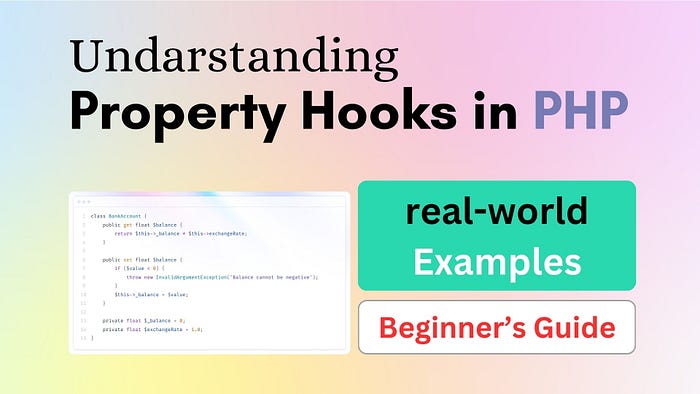From Getters and Setters to Property Hooks in PHP 8.4: A Practical Guide (2025)
Understanding Property Hooks

Introduction
PHP 8.4 introduces a groundbreaking feature called Property Hooks, transforming how developers handle class properties. This innovative approach replaces traditional getter and setter methods with a more elegant, powerful syntax that simplifies property access control while maintaining clean, maintainable code.
Understanding Property Hooks
Property hooks are specialized methods that intercept property access and modification, providing a direct, intuitive way to manage class properties. Unlike traditional getter and setter methods, property hooks offer a seamless mechanism to control property interactions with built-in type safety and validation.
Key Benefits of Property Hooks
- Simplified Syntax: Eliminate verbose getter and setter methods
- Enhanced Encapsulation: Maintain strict control over property access
- Improved Type Safety: Leverage built-in type checking
- Better Performance: Achieve direct property-like access with robust validation
Practical Implementation
Let’s dive into a concrete example that illustrates the power of property hooks. Consider a BankAccount class that requires sophisticated balance management:
class BankAccount {
public get float $balance {
return $this->_balance * $this->exchangeRate;
}
public set float $balance {
if ($value < 0) {
throw new InvalidArgumentException('Balance cannot be negative');
}
$this->_balance = $value;
}
private float $_balance = 0;
private float $exchangeRate = 1.0;
}In this example, the property hook for balance demonstrates several powerful capabilities:
- Automatic currency conversion through the
exchangeRate - Validation to prevent negative balances
- Type-safe float handling
- Clean, readable property access
Real-World Scenario: E-commerce Product Pricing
Another practical use case is managing product pricing in an e-commerce application:
class Product {
public get float $price {
return $this->basePrice * (1 - $this->discount);
}
public set float $price {
if ($value <= 0) {
throw new InvalidArgumentException('Price must be positive');
}
$this->basePrice = $value;
}
private float $basePrice = 0;
private float $discount = 0;
}
// Usage example
$product = new Product();
$product->price = 99.99; // Sets base price
echo $product->price; // Calculates price with discountThis example showcases how property hooks can:
- Implement complex pricing calculations
- Enforce business rules (positive pricing)
- Provide a clean interface for price manipulation
Advantages Over Traditional Approaches
Traditional getter and setter methods often lead to:
- Verbose, repetitive code
- Reduced readability
- Potential inconsistent validation
- Performance overhead from method calls
Property hooks address these challenges by:
- Providing a more concise syntax
- Centralizing property access logic
- Maintaining strong type safety
- Offering direct property-like access
Best Practices
When implementing property hooks:
- Use them for complex property logic
- Ensure type safety
- Implement comprehensive validation
- Keep hook implementations focused and clear
Conclusion
Property hooks in PHP 8.4 represent a significant leap forward in object-oriented programming. By providing a more elegant, powerful way to manage class properties, they enable developers to write more maintainable, readable, and robust code.
As with any new language feature, the key is understanding its strengths and applying it judiciously. Property hooks are not a replacement for all getter and setter methods, but a powerful tool in your PHP development arsenal.
Getting Started
- Upgrade to PHP 8.4
- Experiment with property hooks in your projects
- Refactor existing getter/setter methods
- Share your experiences with the PHP community
Are you ready to revolutionize your approach to property management in PHP?
